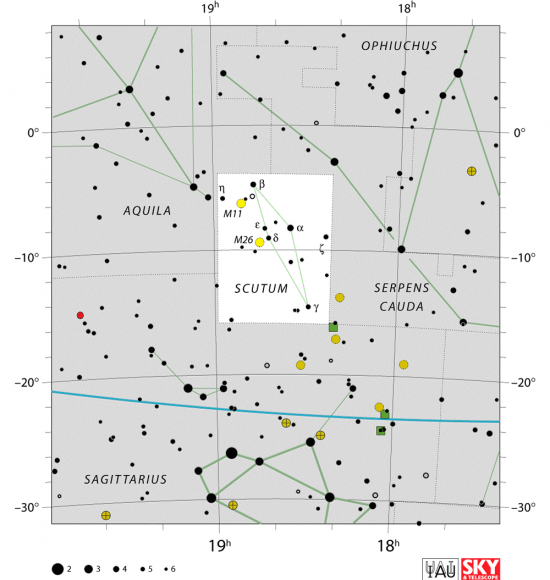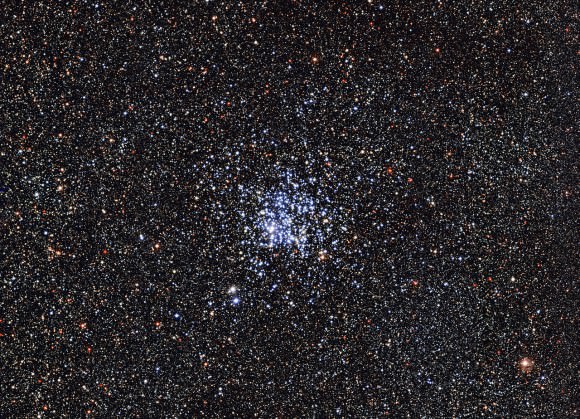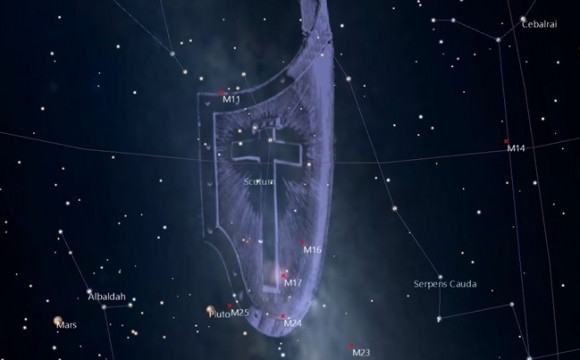Welcome back to another edition of Messier Monday! Today, we continue in our tribute to Tammy Plotner with a look at the M11 Wild Duck Cluster!
In the 18th century, French astronomer Charles Messier noted the presence of several “nebulous objects” in the night sky while searching for comets. Hoping to ensure that other astronomers did not make the same mistake, he began compiling a list of 1oo of them. This list came to be known as the Messier Catalog, and would have far-reaching consequences.
One of these objects is M11, otherwise known as The Wild Duck Cluster, an open cluster located in the constellation Scutum, near the northern edge of a rich Milky Way star cloud (the Scutum Cloud). This open star cluster is one of the richest and most compact of all those known, composed of a few thousand hot, young stars that are only a few million years old.
Description:
At around 220 million years old, Messier 11 is one of the richest and most compact of the known open clusters, containing about 2900 stars. Its brightest and hottest main sequence stars are of spectral type B8 and it also contains many yellow and red giant stars. Speeding away from us at 22 kilometers per second, a total of 82 variable stars have so far been discovered amidst its vast population.
Many pulsating stars and eclipsing binaries in the region of M11 are probable members of the cluster as well. M11 has also been studied for its metallicity content, because metallicity estimates will be useful in planning future extrasolar planet transit searches, since planets may form more readily in metal-rich environments.

As J.L. Marshall, an astronomer from the University of Ohio, described the cluster in the 2005 study “Survey for Transiting Extrasolar Planets in Stellar Systems. II. Spectrophotometry and Metallicities of Open Clusters“:
“Galactic open clusters occupy a wide range of ages, sizes, initial mass functions, and metallicities, and they are found throughout the Galactic disk. Thus, open clusters are excellent tracers of Galactic disk properties and give insight into the formation of the disk. Unfortunately, the fundamental properties of open clusters are difficult to determine. Current estimates of these properties vary widely; there is only marginal agreement in the literature about the age, metallicity, reddening, or galactocentric distance of any given open cluster. Part of the disparity between estimates is due to the variety of methods used to determine these quantities. The published metallicity estimates of an open cluster are especially prone to disagreement because each technique has different sensitivities to metallicity patterns, and it is likely that none of the methods commonly used to estimate stellar metallicity, with the possible exception of high-resolution spectroscopy, is measuring the “true” metallicity of the stars. Additionally, the relationship between the many different techniques is often unknown. The past few decades have yielded significant advances in the study of open clusters, but there is still much work to be done toward determining the fundamental properties of the more than 1500 currently known Galactic open clusters. Nonetheless, open clusters are extremely useful objects to study, because each cluster represents a homogeneous set of stars. All stars in an open cluster form at the same time and in the same circumstances and thus are expected to have the same age, metallicity, and galactocentric distance. For this reason, open clusters are good test beds for many types of Galactic studies. For example, they may be ideal objects in which to search for extrasolar planets. Furthermore, open clusters can be metal-rich objects. Metal-rich environments have recently received attention due to the suggestion that extrasolar planets form more readily around metal-rich stars. If this is the case, metal-rich open clusters may be excellent places to search for extrasolar planets.”
By studying the integrated light and photometric colors, scientists have been able to determine that Messier 11 is relatively old. According the the research of R. Sagar and H. C. Bhatt: “This could be due to the fact that the number of evolved massive red stars in the cluster is low. Such things can be observed if star formation in the cluster was not coeval and more massive stars were formed towards the end in the central region.”

But why is studying what we see so close to home important? According to S. Lata, it is because:
“Star clusters in a galaxy play an important role in understanding the processes of star formation and stellar evolution in the galaxy as well as galactic structure and evolution. The physical quantities required for such studies are best determined from the observations of individual cluster members. Unfortunately, such observations are not possible in the case of extra-galactic clusters because ground based optical telescopes can not resolve member stars that are separated by less than 1 arcsec. Even with the Hubble Space Telescope, where resolution is improved to 0.1 arcsec, all cluster members cannot be observed in galaxies like M 31, M 33 etc. On the other hand, in such cases integrated photometric parameters can still be observable and, in fact, integrated colours and spectra will remain for long time to come the only way to investigate the evolutionary history of stellar systems beyond the local group of galaxies. To interpret these parameters in terms of age, stellar content, metallicity etc. of the extra-galactic star clusters, it is necessary to study the integrated photometric parameters of those star clusters of our galaxy where observations of individual cluster members provide these parameters. Without understanding these integrated parameters, it may not be possible to study the observations of integrated light of star clusters of other galaxies, wherein it is not practical even to visually separate out the open clusters from the globulars. Integrated light characteristics of star clusters are thus very important.”
History of Observation:
M11 was first discovered German astronomer Gottfried Kirch of the Berlin observatory in 1681 and it is historically believed to have been first resolved into stars by William Derham about 1733. However, it became famous when Charles Messier included it in his catalog on May 30, 1764. As he recorded in his notes at the time:
“In the night of May 30 to 31, 1764, I have discovered, near the star Kappa of Antinous, a cluster of a large number of small stars which one perceives with good instruments; I have employed for this a Gregorian telescope which magnifies 104 times. When one examines it with an ordinary [non-chromatic] refractor of 3 and a half feet [FL], this star cluster resembles a comet; the center is brilliant, there is among the small stars one star of eighth magnitude; two other, one of the ninth and one of the tenth: this cluster is intermixed with a faint light, and its diameter is about 4 minutes of arc. I have determined its position in right ascension as 279d 35′ 43″, and its declination of 6d 31′ 1” south. Mr. Halley reports in the Philosophical Transactions, no. 347, page 390, that Mr. Kirch did the discovery of that nebula in 1681, that it precedes the right foot of Antinous, that it isn’t itself anything but a small obscure patch, and that it contains a star which rather shines when traversing it, what gives it more light, its [ecliptical] longitude was in the [sign] Capricorn at 9 degrees [279 deg]; with 17d 1/2 northern latitude. That nebula was consequently observed by Derham, (Philosophical Transactions, no. 428, page 70) he reports, it follows a translation of his Memoir [here actually a transcript]: “Five of these six I have carefully viewed with my excellent eight Foot Reflecting Telescope, and find them to be Phaenomena much alike ; all except that preceding the right Foot of Antinous, which is not a Nebulose, but a Cluster of Stars, somewhat like that which is the Milky-Way.” Mr. le Gentil also mentioned it in the Memoirs of the Academy of 1759, page 469. M. de Chéseaux has employed a Gregorian telescope of two feet, and a refractor of 25 feet [focal] length for examining that nebula in Antinous, which he had recognized to be a prodigious cluster of small stars; M. le Gentil made use of a [reflecting] telescope of 3 feet and an ordinary [non-achromatic] refractor of 20 feet [focal] length, making at least the same effect as the [reflecting] telescope and the refractor of M. de Chéseaux; he recognized that the nebula was very bad terminated at its preceding border, the sort which imitates rather well at this side, the coma of a Comet; he didn’t perceive in the middle that a single bright star which one doesn’t perceive, he said, but with a refractor of 8 feet. M. le Gentil thinks M. de Chéseaux has indeed confused that nebula with a neighboring cloud which contains a prodigious number of small stars.”

Historically speaking, that’s not a bad description. But as with many Messier Objects, the credit for the most apt and detailed description again goes to Admiral Smyth:
“A splendid cluster of stars, closely to the east-south-east of the above described object [a double star]; it precedes the left foot of Antinous, and is on the dexter chief of Sobieski’s shield [Scutum]. This object, which somewhat resembles a flight of wild ducks in shape, is a gathering of minute stars, with a prominent 8th-magnitude in the middle, and two following; but by all analogy these are decidedly between us and the cluster. This, however, was not the opinion of Kirch, its discoverer, who, in 1681, described it as a small obscure spot, with a star shining through, and rendering it more luminous. Dr. Derham first resolved it into stars, with his 8-foot reflector, as shown in the Philosophical Transactions for 1733: “it is not,” said he, “a nebulose, but a cluster of stars, somewhat like that which is in the Milky Way.” That in the Milky Way! Dr. Halley drew up a description of the nebular wonders, in 1716. They then amounted to six; but he says, “There are undoubtedly more which have not yet come to our knowledge.” He could little foresee the rich harvest which was soon reaped; but his reasoning was very fair for the commencement. “Through all these spots,” he observes, “are in appearance but little, and most of them but a few minutes in diameter; yet since they are among the fixt stars, that is, since they have no annual parallax, they cannot fail to occupy spaces immensely great, and perhaps not less than our whole solar system. In all these vast spaces it should seem that there is a perpetual uninterrupted day, which may furnish matter of speculation, as well to the curious naturalist as to the astronomer.” This fine object is on the shield by which Hevelius intended, FOR EVER, to honor John III., king of Poland. In the Prodomus Astronomiae, he appears to be uncommonly elated on having raised it to perpetual memory of the glorious liberator of Vienna – “ob immensa ejus merita, heroicas animi dotes, magnanimitatem, et ob res strenuè, ac fortiter gestas.” He was delighted in being able to place it in the happiest part of the firmament, where all the members and neighbors are significant. “I wish to know, benevolant reader,” he says, “that this shield consists of lucid stars, partly of the fourth magnitude; four of these are placed in the border of this shield, and designate the princes of our serene king, who at that time were all among the living. In the middle of the shield I have designed a cross, in eternal remembrance of the battles most happily fought by him for the Christian faith: three notable stars shine in this cross, of which one indicates his own royal person, another the queen’s, and a third the princess’s, his only daughter; so that these seven stars represent the whole reigning family.” This, and much more, shows his anxiety and hope of its eternal duration; but, poor fellow, Mr. Baily has taken the field, and Sobieski is one of the first among the asterisms recently doomed to proscription. I hope his pruning-knife is to be applied to many other interlopers, most of whom are far more pretty than this.”
So where do the “wild ducks” come into play? It seems no one is too sure of who first began calling this open star cluster by this name. But it is the general consensus that the name arose as a result of the object resembling the V-shape of a flight of ducks, when viewed through a small telescope.
Locating Messier 11:
The Wild Duck Cluster is one of the easier objects to find in the night sy. Although M11 is in the constellation of Scutum, use Aquila as your guide. Its distinctive “T” shape shows in even relatively light polluted areas! Beginning with Altair (Alpha Scu), count four stars down the back towards the south. At the end of this chain, you will see two stars close together. Starhop almost this same distance west and you’ll find Messier 11 with ease!
Using binoculars, it will show as a distinctive diamond-shaped compression of starfield and will begin some resolution. In the finderscope it will appear as a small hazy patch. Even in a small telescope it will resolve into a glorious open cluster and will show hundreds of stars to larger aperture.
And here are the quick facts on M11, for your convenience:
Object Name: Messier 11
Alternative Designations: M11, NGC 6705, “Wild Duck” Cluster
Object Type: Open Star Cluster
Constellation: Scutum
Right Ascension: 18 : 51.1 (h:m)
Declination: -06 : 16 (deg:m)
Distance: 6.0 (kly)
Visual Brightness: 6.3 (mag)
Apparent Dimension: 14.0 (arc min)
Good luck with your “duck hunting”! Just remember, the only thing you need to be armed with here is a pair of binoculars or a telescope.
We have written many interesting articles about Messier Objects here at Universe Today. Here’s Tammy Plotner’s Introduction to the Messier Objects, , M1 – The Crab Nebula, M8 – The Lagoon Nebula, and David Dickison’s articles on the 2013 and 2014 Messier Marathons.
Be to sure to check out our complete Messier Catalog. And for more information, check out the SEDS Messier Database.

